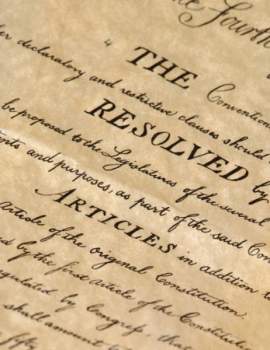
Know The Nature and Role of The SC Justices

Popular In Constitution
Purpose Of Lifetime Appointment And Pros And Cons Enumerated Powers Bicameral Legislature Background Article 3 Of The Constitution We The People 1st Amendment Who Wrote The Constitution Judicial Review Equal Protection Clause Three Fifths Compromise 10th Amendment 5th Amendment
The nature and role of Supreme Court Justices is left quite open by the relevant section of the Constitution, Article III, on the issue of "Judicial Powers", as well as a brief reference to the existence of the office of Chief Supreme Court Justice in Article I. The rules and procedures of this office were addressed most early on in the first Congressional legislation, the Judiciary Act of 1789.
This Bill fixed the number of Supreme Court Justices, the structure in which they would operate and the responsibilities and powers which they would hold. Many of these rules would later be changed. In addition to formal legislative reform, the Supreme Court Justice role has also been changed and affected by the tasks taken on by specific members on the bench and by the requirements of the country as a whole.
The bench was originally comprised of six Supreme Court Justices, who were first officially convened on the first of February, 1790, in New York City. However, only by the next day would their full number assemble. At this point, Supreme Court Justices faced a substantial responsibility in addition to that of presiding over appellate courts, in the form of "circuit riding", by which each Supreme Court Justice had the annual duty to personally preside over a pair of proceedings in each of the country's districts. The Justices felt at this time that the obligation significantly and unnecessarily interfered with their main duties on the bench.
More general complaints were commonly aired by Supreme Court Justices in the institution's first decade of existence as to the limited scope of the Court's powers. This grievance began to subside with the beginning of the term of the fourth Chief Justice, John Marshall, in 1801. Under his tenure, the power of judicial review was first made available in practice to Supreme Court decisions, as established by his decision in the case of Marbury v. Madison.
The onerous circuit-riding requirement, however, was not removed until 1891. Another source for instability in the Court was the changing required numbers for Supreme Court Justices, which was eventually eased in 1869 with the decisive establishment of a nine-Justice membership.
Another important point for Supreme Court Justices in general of Marshall's tenure as Chief Justice was the length of his term, which lasted for 34 years up until his death. As a supporting example of this principle, several of Marshall's Associate Justices had terms lasting over twenty years.
According to Article III, a Supreme Court Justice can serve "during Good behavior". Without any stipulation for resignation, this is generally assumed to mean life. It is difficult and generally unlikely for a Supreme Court Justice to be removed from the bench, a procedure which can only be realized through Congressional impeachment and in practice has only been fully attempted once, toward Samuel Chase in 1805 with a conclusion of acquittal. In the early 21st Century, the average service of a Supreme Court Justice has been found to be 15 years.
NEXT: What You Need To Know About Judicial Leanings





















